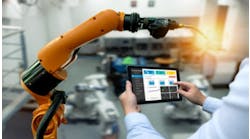System integrators should scream "Show me the money!"
During the recent Control System Integrators Association (CSIA) Executive Conference in Denver, Colorado, attendees discussed the future of work and, during one presentation, borrowed a famous line from Jerry Maguire to inspire system integrators to demand fair treatment.
We wanted to learn more, so we connected with CSIA member Renato Leal, CEO of Brazil-based GreyLogix Brasil Automacao Industrial. Take a look…
Smart Industry: What was the key takeaway from them "Show Me The Money" presentation?
Renato: “Show Me The Money" was about the commercial aspects of Industry 4.0 and digital transformation. A key takeaway is the fact that system integrators are the most suitable players to capitalize on this industrial revolution, but most of them still do not know how to do it.
Smart Industry: What is the future of work?
Renato: At some point in the future, there should be no industrial labor. It might be in 50, 100, 200 years. Regardless of how long it will take, the fact is that eventually we will get there. That means that all the industrial manpower shall be taken by machines and/or robots. Having that in mind, it is reasonable to imagine we should have stronger industries, generating more results, creating more value. It also means we shall have people idleness and that can become either a problem or a huge opportunity for mankind. If resources and trainings are applied with the right focus, we can have people specializing more and more in industrial business intelligence, software optimization, new business models and new businesses.
Smart Industry: Are these changes regional? Is the future of work in Brazil different than US?
Renato: When industries become truly 4.0 (or higher) as a standard, we should face some interesting paradigm shifts in operation costs, which might impact entire supply chains. When labor is no longer a relevant variable for industries, the focus will be mostly on energy costs, consumer-market size and supply chain proximity (physical and cultural). Countries like Brazil, which have no commercial enemies, a strong internal market and a clean/cheap power grid might benefit from this new scenario. The United States has a few commercial “enemies” as a weakness, but the country continues to be a huge international power, has a large internal market and the strongest educational system to quickly adapt its manpower to the future of work. I would bet both countries will do very well in future global trends.
Smart Industry: How are digital tools / techniques prompting the adoption of these new ways of working?
Renato: Digital tools are mandatory for the current and new ways of working. We currently have projects where we collaborate with engineers from three different continents in real-time. That was unthinkable only a few years ago and now it is becoming a standard. As we progress in the new forms of work, digital tools will continue increasing their already fundamental role. With the development of better collaboration tools, there are few boundaries for creating “super teams” and industrial-development speed will continue to increase.
Smart Industry: What are you most excited about in the near future of manufacturing?
Renato: I am very excited about the development of digital twins. I see a major paradigm shift in the way industries are built. I am also excited about the recurring-revenue models that are emerging by packaging solutions as services.
Of course, the tricky thing about recurring revenues is that from the customer perspective they are recurring costs, so it can become a zero-sum game if you are fighting to push recurring revenues without a good value proposition. Like Netflix, if you want to sell recurrently, you must have solid content. In our case, it meant choosing a great tool (COMOS, from SIEMENS), investing heavily in software licenses and even more in developing a solid team for database administration, engineering, maintenance and support. We put that all in a package and rent it to our customers.
Basically, we build their digital-twin environment with smart piping-and-instrumentation diagrams, integrated documentation, maintenance, engineering and so on and we rent it to them including setup, licenses and services. So, the customers can have an as-is version of their plant instead of as-built.
It has been a success. In fact, the model has proven so successful that we are partnering with other system integrators and construction companies worldwide, where we maintain and update their databases and they rent or sell the digital twins to their own customers. This is only one example of the many new opportunities arising from Industry 4.0. These are exciting times with a whole new generation of solutions for industries, and opportunities are up for grabs.


